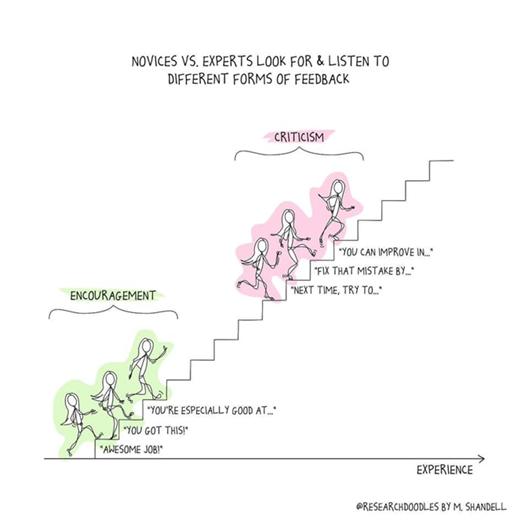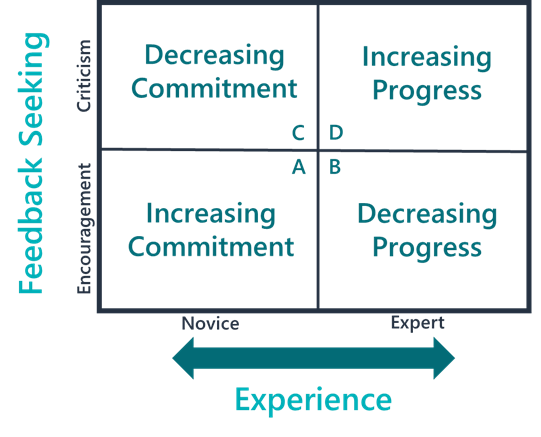We have two sides to ourselves:
- Our DOING Side: Our knowledge, skills, talents and abilities
- Our BEING Side: Our character, mindsets, and psyche

For most people and leaders:
- We are more advanced on our DOING Side than our BEING Side
- Almost all development efforts (across education, athletics, and organizational development) focus on the DOING Side
- Our biggest struggles generally relate to deficiencies in our BEING Side
In fact, I am learning that the higher we are on our BEING Side:
- The more effectively we navigate life
- The more effective we are as leaders
- The more we get out of our DOING Side
Recognizing all of this, do you know the altitude of your BEING Side?
I want to give you one measure (surely not the only measure) of the altitude on your BEING Side: Your relationship with feedback.
Your Relationship with Feedback – Part 1
When we compare people higher on their BEING Side with people lower on their BEING Side, a couple of key differences we will spot is that people lower on their BEING Side are:
- They are internally programmed for self-protection (versus value creation)
- They have more narrow windows of tolerance (as opposed to wider windows of tolerance)
Recognizing this, one example that I commonly use to help people connect with these ideas is this…
How do you think most people respond to constructive criticism or feedback?
The answer I most commonly get is: Defensive.
Getting defensive when receiving constructive criticism or feedback:
- Suggests a narrow window of tolerance (as they were unable to stay calm, present, and balanced when they received the constructive criticism or feedback)
- Is the result of self-protective programming
Thus, the degree to which we get defensive when receiving constructive criticism or feedback is one way to gauge our altitude on our BEING Side.
The people who are at a high altitude on their BEING Side see constructive criticism and feedback as opportunities to learn and grow. They create space for constructive criticism and feedback and seek to learn from it as opposed to get defensive and dismiss it.
Your Relationship with Feedback – Part 2
But, let me give you another 2×2 framework that I think you will find interesting to think about.
I was recently introduced to some research by Stacey Finkelstein and Ayelet Fishbach by Adam Grant, which found that generally:
- Novices (low experience) seek out and respond more positively to encouragement as opposed to criticism (compared to experts)
- Experts (high experience) seek out and respond more positively to criticism compared to novices
Adam Grant shared this image to depict this finding:

But, in my experience working with executives and leaders, I have observed a lot of leaders who are unwilling to receive criticism. This experience has motivated me to develop the 2×2 below. And, in each of the quadrants, I put what I believe is the likely outcome for people who operate in these different quadrants.

My motivation for creating this 2×2 is twofold:
- To point out that if executives and leaders operate in Quadrant B (which from my experience is a common phenomenon), they are significantly limiting the progress of their organization and teams.
- To point out that operating in Quadrant B is a signal of being lower along our BEING Side. Being in Quadrant B suggests that we have a narrow window of tolerance for criticism and feedback and operate from a place of self-protection instead of value creation.
Now What?
If you want to elevate along your BEING Side, you need to (1) learn more about your BEING Side, (2) deepen your self-awareness of your BEING Side, and (3) engage in efforts to elevate along your BEING Side. One place to go to for more information about how to do this is my book: The Elevated Leader. I am also working on my next book that dives more directly into these ideas.
Also, I am starting my Vertical Development Coaching Program on February 9th. Let me know if you would like to join.
If you want to help leaders in your organization elevate along their BEING Side, I am your guy. Let’s connect and discuss how I can help you.










2 Responses
Good morning Ryan. I love this whole concept about connecting feedback to who we are. One of my personal goals in teaching feedback a lot is to try to eliminate the words “constructive criticism” together. Criticism, by definition, is judgmental and condemning. It’s looking backwards. I don’t find that it’s possible to be constructive and judgmental at the same time. I very much encourage people to use the word feedback because the definition of that is a basis for improvement. Those are my “doing”thoughts for today.
Great comment! You are tapping into something deep and rich: there are deep-seated emotions that come up for us even just talking about feedback (and criticism), let alone receiving it.